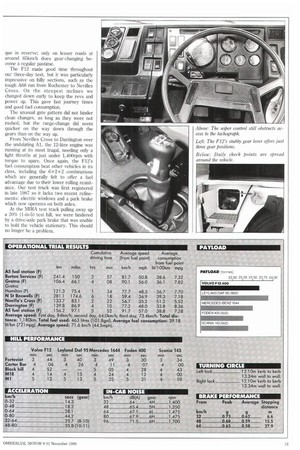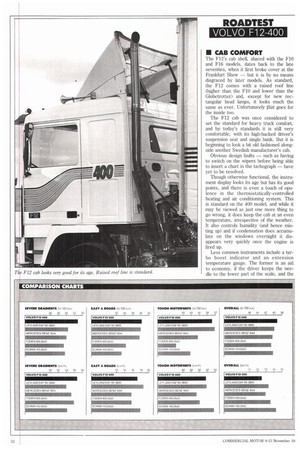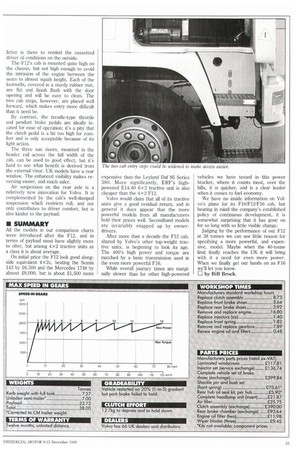MORE THAN
Page 51

Page 52

Page 53

Page 54

Page 55

If you've noticed an error in this article please click here to report it so we can fix it.
NOUGH
Volvo's mighty F16 has elbowed the Fl 2 out of the limelight — but after three days on the road with the Fl 2-400, we wonder if the Fl 6's extra power is really necessary.
• Ever since the mighty F16 became Volvo's flagship back in October 1987, the previously all-conquering F12 has been gently eased out of centre stage.
No longer does it have the biggest, most powerful engine, no longer is it the Volvo that everyone wants to drive. At shows it is just one of the company's many models that are available between 7.5 and 38 tonnes. Meanwhile, the F16 has been rubbing the F12's nose in it with its new 375kW (485hp) TD162F engine (hyped as "Europe's most powerful truck engine!", although the claim is based on maximum torque, not outright power).
Whichever way you look at it, the F12 now plays second fiddle. to the F16 — but this fiddle has a 12-litre engine and nigh on 298kW (400hp)). So why aren't we testing an F16?
Maybe Volvo feels it is not worth the expense involved to promote the sales of tractive units with such a high power rating where demand is still relatively small.
Then again, with over 298kW on tap maybe Volvo doesn't want to make too much of the kind of fuel consumption it might return around our Scottish test route. Just for the record, all the tractive units in this high power range tested by Commercial Motor have proved to be far from frugal. Or maybe they were just waiting until they were able to offer us an F16-485 with the new engine.
Whatever the reason, when Volvo offered us an F12 for test we were not about to turn it down, for the last time we drove one in anger was back in 1982, and seven years is a long time in the production run of any vehicle. But if fuel economy is the measure of the F12, we may have been waiting for the wrong truck.
• FUEL CONSUMPTION
Over our 1,180km test route it set a new standard in the realms of high-powered 38-tonne tractive units with a sparkling 39.181k/100km (7.21mpg). That is in itself an impressive figure — when the F12's 72.5km/h (45.1mph) average speed is taken into account we wonder how many operators will attempt to justify the extra costs of the F16.
Beneath the skin this F12 has little in common with its 1982 predecessor. Its charge-cooled engine churns out 56kW (82hp) more power, and torque is up 29% at 1,650Nm. In isolation this could hit driveline reliability, so a larger clutch and a stronger gearbox (with fewer ratios) have been added.
Although the gearbox is similar in construction to earlier models, it incorporates a stronger epicyclic range-change unit and an unusual three-position gate which is
used to select all forward gears. (This three-position design is also used in the F16's SR2000 transmission).
Its high-tensile steel chassis appears to be unchanged, but its design weight has been increased with a stronger front axle rated at 6.7 tonnes and aheavier drive axle, up from 10.16 tonnes to 13 tonnes. This in turn has led to larger-diameter brake drums (up 16mm to 410mm) with wider linings at the rear.
The 1i12's high power-to-weight ratio makes driving very easy — to appreciate how easy you need to experience it first hand. More than 7,000 drivers have done just that over the past 18 months in our test vehicle, a well-run-in company demonstrator.
The word Volvo translates from Latin as "I roll" (and not a lot of people know that!). The F12 does indeed roll along freely and during our test had to be restrained, using a combination of the exhaust brake and intermediate gearing, to combat gathering momentum on some of the longer downhill sections.
• PERFORMANCE
On the easier motorway sections the F12 cruises effortlessly at the legal limit at about 1,650rpm. At slower speeds over A-road dual carriageways, the 12-litre engine works very economically at around 1,350rpm in top gear with plenty of tor que in reserve; only on lesser roads at around 65km/h does gear-changing become a regular pastime.
The F12 made good time throughout our three-day test, but it was particularly impressive on hilly sections, such as the tough A68 run from Rochester to NeviIles Cross. On the steepest inclines we changed down early to keep the revs and power up. This gave fast journey times and good fuel consumption.
The unusual gate pattern did not hinder clean changes, as long as they were not rushed, but the range-change did seem quicker on the way down through the gears than on the way up.
From NeviIles Cross to Darrington over the undulating Al, the 12-litre engine was running at its most frugal, needing only a light throttle at just under 1,400rpm with torque to spare. Once again, the F12's fuel consumption beat other vehicles in its class, including the 6x2+2 combinations which are generally felt to offer a fuel advantage due to their lower rolling resistance. Our test truck was first registered in late 1987 so it lacks two recent refinements: electric windows and a park brake which now operates on both axles.
At the MIRA test track pulling away up a 20% (1-in-5) test hill, we were hindered by a drive-axle park brake that was unable to hold the vehicle stationary. This should no longer be a problem.
• CAB COMFORT
The F12's cab shell, shared with the F10 and F16 models, dates back to the late seventies, when it first broke cover at the Frankfurt Show — but it is by no means disgraced by later models. As standard, the F12 comes with a raised roof line (higher than the F10 and lower than the Globetrotter) and, except for new rectangular head lamps, it looks much the same as ever. Unfortunately that goes for the inside too.
The F12 cab was once considered to set the standard for heavy truck comfort, and by today's standards it is still very comfortable, with its high-backed driver's suspension seat and single bunk. But it is beginning to look a bit old fashioned alongside another Swedish manufacturer's cab.
Obvious design faults — such as having to switch on the wipers before being able to insert a chart in the tachograph — have yet to be resolved.
Though otherwise functional, the instrument display looks its age but has its good points, and there is even a touch of opulence in the thermostatically-controlled heating and air conditioning system. This is standard on the 400 model, and while it may be viewed as just one more thing to go wrong, it does keep the cab at an even temperature, irrespective of the weather. It also controls humidity (and hence misting up) and if condensation does accumulate on the windows overnight it disappears very quickly once the engine is fired up.
Less common instruments include a turbo boost indicator and an extension temperature gauge. The former is an aid to economy, if the driver keeps the needle to the lower part of the scale, and the latter is there to remind the cossetted driver of conditions on the outside.
The F12's cab is mounted quite high on the chassis, but not high enough to avoid the intrusion of the engine between the seats to almost squab height. Each of the footwells, covered in a sturdy rubber mat, are flat and finish flush with the door opening and will be easy to clean. The two cab steps, however, are placed well forward, which makes entry more difficult than it need be.
By contrast, the treadle-type throttle and pendant brake pedals are ideally located for ease of operation; it's a pity that the clutch pedal is a bit too high for comfort and is only acceptable because of its light action.
The three sun visors, mounted in the header rail across the full width of the cab, can be used to good effect, but it's hard to see what benefit is derived from the external visor. UK models have a rear window. The enhanced visibility makes reversing easier, and much safer.
Air suspension on the rear axle is a relatively new innovation for Volvo. It is complemented by the cab's well-damped suspension which restricts roll, and not only contributes to driver comfort, but is also kinder to the payload.
• SUMMARY
All the models in our comparison charts were introduced after the F12, and in terms of payload most have slightly more to offer, but among 4x2 tractive units as a class it is about average.
On initial price the F12 look good alongside equivalent 4x 2s, beating the Scania 143 by 26,500 and the Mercedes 1748 by almost 29,000, but is about £1,500 more expensive than the Leyland Daf 95 Series 380. More significantly, ERF's highpowered E14.40 6x2 tractive unit is also cheaper than the 4 x 2 F12.
Volvo would claim that all of its tractive units give a good residual return, and in general it does appear that the more powerful models from all manufacturers hold their prices well. Secondhand models are invariably snapped up by ownerdrivers.
After more than a decade the F12 cab, shared by Volvo's other top-weight tractive units, is beginning to look its age. The 400's high power and torque are matched by a basic transmission used in the even more powerful F16.
While overall journey times are marginally slower than for other high-powered vehicles we have tested in this power bracket, where it counts most, over the hills, it is quicker, and is a clear leader when it comes to fuel economy.
We have no inside information on Volvo's plans for its F10/F12/F16 cab, but bearing in mind the company's established policy of continuous development, it is somewhat surprising that it has gone on for so long with so little visible change.
Judging by the performance of our F12 at 38 tonnes we can see little reason for specifying a more powerful, and expensive, model. Maybe when the 40-tonne limit finally reaches the UK it will bring with it a need for even more power. When we finally get our hands on an F16 we'll let you know.
El by Bill Brock.




























































































































